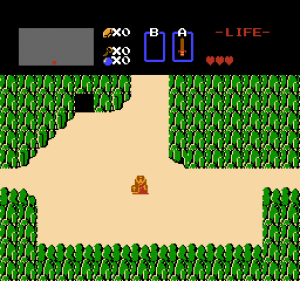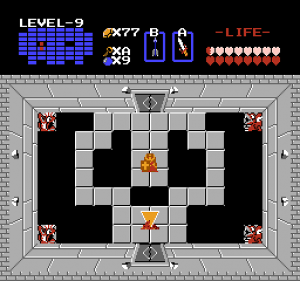“I am Zelda, and I’ll be fighting for my own kingdom!”
How a sprite swap changes the story
Yesterday, Leon Arnott dropped several links related to gender-swapped games. Among them was this gem.
(The Legend Of ) Zelda Starring Zelda by Kenna W
According to Kenna, this came in reaction to Anita Sarkeesian’s Tropes vs Women in Videogames – Part 1: Damsels in Distress. (If you haven’t seen it, open it in a new tab and make that the next thing you do today.) In it, Sarkeesian deconstructs the “Damsel In Distress” narrative trope, which is very nearly a defining characteristic of The Legend of Zelda series. Zelda is captured by Ganondorf, Link grabs a sword to rescue her, rinse, repeat.
Yet, this is all in retrospect. When I was a kid, I had no concept of any of the gender issues* with the game; this was just a really cool game. I do recall asking why the title was The Legend of Zelda since it was about Link, and in fact, I discovered the secret Second Quest because I named Link “ZELDA” in order to make the title make sense in my 6 year old head. My most powerful memories of the original game weren’t related to gender theory, my most powerful memories were of playing side by side with my father as we mapped out each dungeon ourselves because I was still getting terribly lost. (For the young’ns, we didn’t have GameFAQs in the 1980s) I learned my right hand from my left hand by telling my dad which rupee to pick in the rupee gambling tree.
(*I recognize that its transparency was due to the normative nature of dominant gender categories, not because I was somehow immune to that indoctrination.)
So when I sat down to play the romhack and saw Zelda hoist the sword above her head for herself, ready to take back her kingdom, I cried.
Already, this is not the same game I played as a child.
This idea of a woman doing it for herself brought to mind something else:
How did we get here? How did we get to the point where simply seeing Zelda with the sword is enough to cause such intense feelings to well up? Well, with regards to The Legend of Zelda, Sarkeesian makes this point:
“Over the course of over more than a dozen games spanning a quarter century, all of the incarnations of Princess Zelda have been kidnapped, cursed, possessed, turned to stone, or otherwise disempowered at some point. Zelda has never been the star in her own adventure, nor been a true playable character in the core series.”
The eponymous character in a series of save-the-world adventure games has never saved her own kingdom. All of her power as princess, as guardian of the Triforce, and as a person with agency are swept aside every single time. In fact, the very idea that all of her power is useless compared to a boy with a wooden sword makes me doubt every claim made about her ability, wisdom, and magical power. Instead, those sound a lot more like selling points, things that make her a more valuable prize to whichever man (Link or Ganon) has control of her when the clock runs out, and a lot less like reasons to think she’s a person in her own right.
She’s not just any girl, she’s a rich girl with a kingdom and a magical trinket! But don’t worry! She’s not actually powerful enough or willful enough to be a threat to your rule once you capture her.
That pattern of disempowerment and the refusal to give the title character a playable role in the main series can’t possibly send any other message.
More than just pixels
It’s easy think of this as just a simple flipping of the script, or to look at what Kenna W did and write it off as just shifting pixels around. But in fact, flipping the script works as a tool to highlight sexism precisely because it puts front and center the way men and women are regarded and treated differently. It is not, itself, a solution to sexism, but the very idea that a story’s meaning and spirit can be changed by such a simple thing as a sprite swap shows that the language of gender and its related norms are infused into every aspect of our lives.
What changes when it is Zelda firing the silver arrow into Ganon’s heart at the end?
The Legend of Zelda becomes a story about her deeds, not about what men around her do. Perhaps this is too facile, but it really does change the game on a visceral level. No longer are you a boy conscripted by an old man to save a princess from another man (pig-man, I suppose, in this first incarnation of Ganondorf). You’re a woman on a quest to save her own kingdom, her own people, with her own wits and skill.
All those people you meet throughout the game are your people. They are looking to you to save them from Ganon’s tyranny, not to save their helpless, ineffectual princess. It’s easy to picture them not as simply ill-thought game mechanics (why are all these people hiding in caves?) but rather as secretive resistance, hiding in caves to avoid Ganon’s grasp. They’ve squirreled away these items to help you reclaim your homeland, their homeland. You aren’t some knight errant fighting someone else’s battle out of misguided chivalry; this is personal. This is your battle.
It’s easy to picture that old man in the cave as one of your family’s advisers, who spirited you out of the castle just in time and offers the one last thing he can: a wooden sword. It’s not your family’s heirloom blade, it’s not sufficient for the battles you have ahead, but it’s all he can offer. It becomes a physical token of hope. It may seem a trivial thing, since it was just as much a symbol of hope when passed to Link, but in investing that hope in Zelda herself and not Link, it changes everything about the meaning.
That way it changes the context tells us something about what the original story really was.
When Zelda takes back the second piece of the Triforce from Ganon at the end, she’s reclaiming the power he took from her. When Link does it for her, we see it as a noble gesture that he returns her stolen Ultimate Power That Apparently Isn’t So Ultimate. When she takes back her own power, we see her as deserving in a way that she wasn’t before. When the Triforce was reduced to a bauble to be given to her as a gift, it tells us that it wasn’t anything special to begin with. Or it tells us that Link is that much more chivalrous for magnanimously returning something he has no obligation to return. After all, he did even more than Ganon did to get it. We can rationalize it with magical woo that by keeping it for himself he’d be somehow undeserving blah blah. But that’s an incredibly broken metaphor compared to the unity provided by Zelda proving herself worthy of its power by reclaiming it for herself and by extension, for her people she’s fighting to protect.
Another thing it reveals is just how unnecessary Zelda was to the original story. Being a sprite swap means that the pre-scripted ending sequence just features Link in her place. But now that we know that Zelda has been fighting to save her own kingdom, to reclaim her own power, and to save her own people, who the hell is this dude at the end? She wasn’t fighting to “get the boy.” The purpose of the adventure wasn’t to “win the heart of the prince”, it was to save her fucking kingdom from a tyrant. He’s not a prize, he’s an afterthought.
That disparity between Zelda’s motivation and Link’s should tell us everything we need to know about the Damsel In Distress trope.

